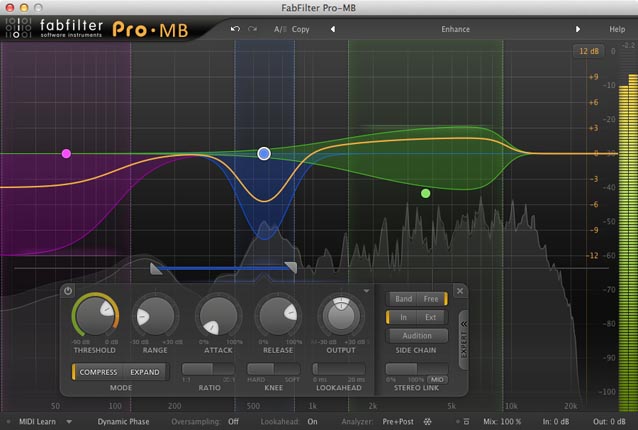Multi-band compression has been around for quite some time and even in the digital realm is accepted as common. But to this regard one could have predicted innovations in that field. Fabfilter implemented these innovations and present to us a new concept of a multiband compressor, Pro-MB.

Myself I’ve been using multiband compression for quite some time now and quite often in the mid/side realm and sometimes even using expanding. The majority of the multiband compressors out there have way too many quirks to use them properly so you use them only if you have to. There aren’t any single solution tools out there and I had to create that from several components that even limited my choice of DAWs due to the routing options. It also makes things quite complicated because you have to keep track of several components and avoid making obvious mistakes. With a single tool solution you can make your work just a bit easier and most of all faster and be finished before the listening fatigue really starts setting in.
Mind you that I’m not going to lecture about multiband compression being not the magical tool that fixes all that it is common claimed by marketeers. It’s simply a tool you can use or abuse any way you see fit. Just as you can use a chainsaw to slice some cake after all.
Everything you edit can be done in the same way as you can do with all fabfilter products and have a clear overview what is going on and what you are editing in a intuitive way.
-You can have up to six processing bands and they don’t have to be adjacent but can be.
-Every band has the common compression parameters and also allow for parallel compression, expansion and upward compression.
-In addition bands can use external side chains or a separate frequency range and allow for mid and side processing.
-Filters for selecting bands have selectable slopes(6-48dB) and can use one out of three phase mode to avoid or minimize phase changes. A rather unique feature in the realm of multiband compressors.

As a user you simply can start by selecting a frequency band. Choose the frequencies of the filters to determine the band you’re working with. Note that you cannot have overlapping frequency ranges but a second instance will do the trick here. For the majority of things three bands usually suffice though, but when looking for multiband more bands don’t equal better. Try to keep it at a minimum would be my suggestion here.
Myself I prefer the highest slopes available when using percussion type sounds. Advantage here is that with minimum phase you will get ever so slightly artifacts. I would advise spending some time looking what options you’d prefer here. Setting compression is rather easy and depending on what you are doing you can go overboard or keep it to a minimum using wet/dry of the expert settings in a sensible way. The ability to hear just the frequency band itself or the side chain input will be of great use determining details fast. As to the compression it resembles a lot to the Pro-C. What I do miss though is the option to chose various types of coloring like the opto or VCA type compression.
As a mixing tool this multiband compressor can be used in various roles. As a simple mono de-esser of some vocals or as a dynamic equalizer to make up for some self-oscillating frequencies. Like a more traditional multiband role.
Expansion can come in handy when you need to breathe some life in some stale samples and give them a bit of spunk without upsetting the rest of the mix too much. Especially if you dial in the side a bit more you can a sweet widening effect from percussion type to stereo lead sounds.
You’ll start entering sculpting territory more when you start using the side chain options of selecting a frequency band or the external input. This can make for extremely tight mixes and there is when the workflow is helping you making things more simple. Just remember the fact that you still can use the wet/dry settings to maintain some of the dynamic content instead of smashing the life out of everything.
When using on the master bus I would advise caution because when pushing hard even this multiband like any other multiband will squeeze the life out of the music. Using for subtle gluing or pushing back some sounds that stick out will work just fine. Especially a booming bass can be tamed if need be and filter out all the side on the lower frequencies to get a more tighter kick and bass. Or when the sound is suffering from digitis you can compress the higher frequencies and emulate tape-saturation without the increase in the mid frequencies.
As to learning what Pro-MB can do those presets can be useful but myself I would never use them. Simply because I rather go in blank and use my own judgment. Maybe for various tasks I could make my own presets but put them in standby mode.
Verdict
In conclusion I can say the Fabfilter Pro-MB is something I’ve literally been waiting for. It makes multiband mid/side compression way easier and more intuitive to use. It’s not the holy grail but can save a lot of mixes when applied with care and self-containment. I do miss compression coloring options though, but hopeful that will be included in another iteration of the product. Nevertheless this is one of the most innovate products of this year and has a very competitive price tag.
Wouter Veltmaat (Serious Mastering)

